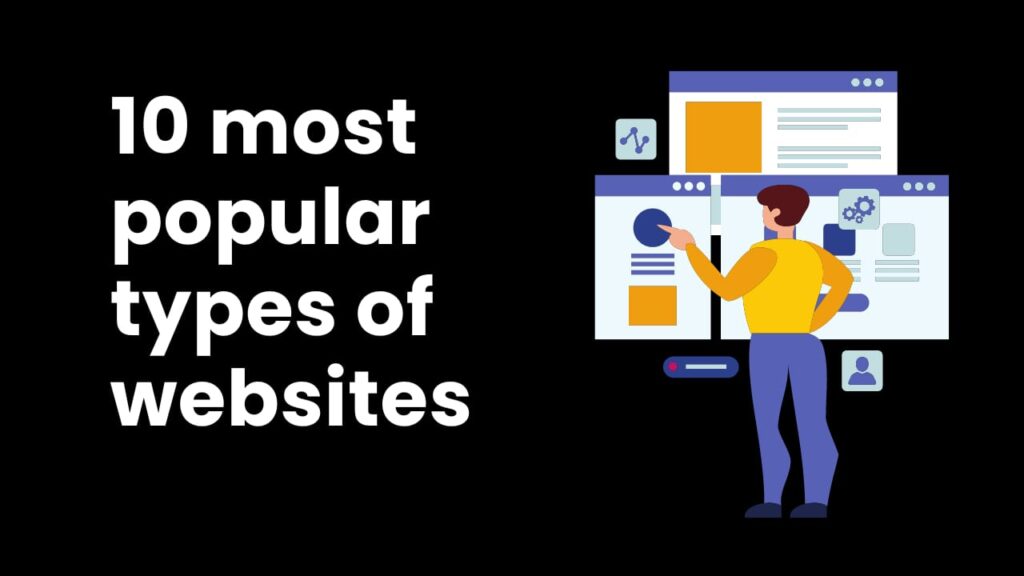With 1.14 billion websites in existence and 252,000 new ones launching every day, the internet is both immense and varied. Each website serves a distinct purpose and targets a specific audience.
From straightforward blogs that provide information to expansive eCommerce platforms selling popular products, and business websites that cater to their clients, the range of options for website creation is extensive.
To simplify the process of choosing the right type of website, it’s helpful to categorise them. In this article, we will explore the 10 most popular types of websites you can create, complete with examples to inspire your own projects.
Let’s dive in.
- Blog Website
A blog is an informational page or online journal that features regularly updated content. New posts are displayed at the top of the list, appearing in reverse chronological order.
Blogs are usually written in a casual, conversational tone and can be managed by individuals or groups.
Popular blog categories include:
- Food blogs
- Travel blogs
- Fashion and Beauty blogs
- Health and Fitness blogs
- Finance and Investing blogs
- Lifestyle blogs
Blogs offer excellent opportunities to earn money online through various methods, such as advertising, affiliate marketing, digital or physical product sales, subscriptions, and coaching or consulting services.
Even if your website isn’t a blog, incorporating a blog can still be beneficial. It can boost visitor numbers and strengthen your site’s credibility. For instance, businesses can use blogs to promote their products and engage with a broader audience. Additionally, blogs can be a platform for sharing entertaining and informative content to increase brand awareness.
Features of a Blog Website
Every website requires certain essential features, such as an appealing web design, user-friendly navigation, and clear calls to action. However, a blog needs additional elements to effectively engage your target audience:
- Fresh Content: Regularly update your blog with new, engaging posts organised into well-defined categories.
- Attention-Grabbing Headlines: Craft compelling headlines to attract readers and encourage them to click on and read your posts.
- Internal and External Linking: Use internal links to facilitate smooth navigation between related posts and external links to enhance the reader’s experience and boost the visibility of your content.
Examples of blog websites:
- The Verge
- Wired
- Billboard
- TechCrunch
- Gizmondo
- eCommerce Website
An eCommerce website is designed for selling products or services online. It can be operated by a single business or serve as a platform for multiple vendors to display their products in a shared online store.
Regardless of its structure, an eCommerce site offers customers a convenient shopping experience with features such as search and filter options, seamless payment processing, integrated shipping methods, and more.
Features of an eCommerce Website
As previously noted, every website requires essential features such as excellent design, a strong brand identity, and high-quality content.
For an eCommerce site, additional critical elements include:
- Robust Security: Ensuring secure transactions is crucial, especially when handling sensitive information like credit card details.
- Easy Navigation: With a wide range of products, it’s vital to provide a user-friendly interface that helps customers quickly find what they need.
- Optimal Mobile Experience: As mobile browsing continues to rise, having a mobile-friendly site is essential for maximising customer engagement and potential.
Example of an eCommerce Website: Zeuss
This eCommerce website stands out with its impressive design, excellent products, and compelling messaging, making it a prime example of a successful online store.
Other notable eCommerce websites include:
- eBay
- Amazon
- Walmart
- Alibaba
- Etsy
- Business Website
A business website serves to provide information about various aspects of a company. Some business sites are designed to cater to customers, while others focus on presenting details about the business, product, or brand.
For example, a business might have a brochure website, a simple site with one or two pages that offer basic information about the company, product, or service.
Alternatively, a business may opt for a comprehensive website that highlights all aspects of its offerings, including a blog that offers insights and tips on how users can maximise the benefits of their purchase.
Features of a Business Website
While all websites should feature excellent design and engaging content, a business website requires specific elements to achieve success. These include:
- A clear purpose or objective
- Strong branding
- Intuitive navigation
- Effective call to action (CTA)
- Easily accessible contact information
Example of a Business Website: Verpex
Verpex offers affordable web hosting solutions tailored to a wide range of users. The company’s website features an attractive design with appealing colors and scroll-triggered animations. The homepage includes testimonials, case studies, and data demonstrating the company’s success in delivering results for clients. This site effectively highlights its services to the public.
Other examples of business websites include:
- The Balloon Queen
- Kraftful
- Moniker
- Patty and Bun
- The People vs Coffee
- Personal Website
A personal website is created by an individual to share content of a personal nature. For instance, someone might build a blog or portfolio to showcase hobbies or design inspirations to family and friends.
Alternatively, professionals might use a personal website as an “online resume” to highlight their work experience and skills.
These websites provide a platform to represent yourself online, giving you complete control over the information you choose to share.
Features of a Personal Website
To enhance your online presence with a personal website, ensure it features the following elements for a polished appearance:
- An About Page: Add an About page detailing who you are, the purpose behind your website, and your goals for it.
- A High-Quality Photo: Include a clear, high-resolution image of yourself on your Home/About page, avoiding photos with other people.
- Contact Information: Provide details on how visitors can reach you online and, if necessary, offline.
Example of a Personal Website: Andy Martin
Andy Martin is a trombonist from Los Angeles who has contributed to over 150 major motion picture soundtracks. His website features details about his albums, soundtracks, and performances, as well as information about his teaching career at USC Thornton School of Music.
Other examples of personal websites include:
- The Beast is Back
- Albino Tonnina
- Devon Stank
- Daniel Grindrod
- Side Hustle Nation
- Portfolio Website
An online portfolio is a website designed for professionals to showcase their creative work. While similar to a personal website, it focuses on increasing online visibility for your name and work.
Ideal for artists, designers, photographers, writers, and other creatives, an online portfolio is an excellent tool for marketing yourself as a professional or freelancer. It allows you to present your work effectively and attract attention from potential clients and employers.
Features of a Portfolio Website
To effectively use your portfolio website as a CV or online resume and boost your visibility, it should include the following features:
- Prominent Branding: Ensure your portfolio site features brand-consistent colours, styles, and a memorable logo to enhance brand recognition.
- High-Quality Images: Along with clear descriptions of your services, include a gallery of high-resolution images to showcase your work.
- Social Proof: Incorporate client testimonials, success stories, reviews, or case studies to build trust with your website visitors.
Example of a Portfolio Website: Gary Vaynerchuk
Gary Vaynerchuk, a renowned public speaker and New York Times best-selling author, features a well-designed portfolio website. It includes essential elements such as a high-quality image, strong branding, and social proof. Additionally, the site showcases a short video montage highlighting his life, achievements, and skills.
Other examples of portfolio websites include:
- Yasio
- Robert Lawler Photography
- Ben Darby
- Charlie Horner Design
- Michael Langley Architecture
- Educational Website
An educational website offers information and resources on various topics. This category includes a broad range of sites such as those for schools, colleges, and universities, online course platforms, and learning management systems (LMS). Additionally, wiki sites and podcast websites also fall under the educational category.
Features of an Educational Website
Educational websites utilize various media, such as articles, videos, images, games, and quizzes, to deliver information and engage their audiences. Whether targeting adults or children, these sites typically share several key characteristics:
- Intuitive Search Functionality: Ensuring visitors can quickly locate the information they need is essential.
- CRM Integration: An easy-to-use content management system is crucial for managing and updating content effectively.
- Engaging Content: While quality content is important for any website, educational sites particularly require engaging material to capture learners’ interest and improve completion rates.
Example of an Educational Website: Skillshare
Skillshare is a website that allows people to learn and exchange knowledge with others. The website encourages immediate interaction from visitors by showcasing a strong call to action to “Get Started for Free”.
Other examples of educational websites:
- Google.com
- YouTube.com
- Schoology.com
- Typing Agent
- Bio-Med Science Academy
- News Website
A news website serves as an online platform for publishing news. Media organizations, such as newspapers, radio stations, and TV channels, often create these websites to extend their services, though some news sites operate independently.
Since their emergence, news websites have provided a quicker and more efficient means of delivering both local and global news to readers.
These sites focus on current affairs, politics, events, sports, and weather, and often cover trending topics similar to entertainment websites, leading to some overlap between the two.
News websites typically monetize through advertising and subscription models.
Features of a News Website
While essential for all websites, certain features are particularly crucial for news and magazine sites:
– **Social Media Integration and Embeds:** Connecting with a wider audience is key, so ensure your site allows for easy sharing and embedding of content from other platforms to enhance your reach.
- User-Friendly Administration: A content management system (CMS) with an intuitive interface is vital for efficiently managing content production and collaboration.
- Optimised Images: Since visual content is increasingly favoured over text, using high-quality, optimised images can make your news content more engaging and accessible.
Example of a News Website: BuzzFeed
This website provides breaking news and essential journalism, along with a range of engaging content, including quizzes, videos, recipes, and celebrity news.
Other examples of news websites include:
- Time.com
- The Washington Post
- BBC
- CNN
- The Daily Telegraph
- Entertainment Website
An entertainment or media website provides content related to sports, movies, current affairs, weather, gaming, and more. These sites are regularly updated with engaging, high-quality content, such as blog posts, videos, films, and news, tailored to their target audience.
The popularity of such websites stems from the fundamental role entertainment plays in life. It not only refreshes the mind but also supports mental health and emotional well-being.
This category includes magazine sites, gaming portals, movie streaming or download sites, podcast platforms, and music websites. Some educational, news, or podcast sites, like Spotify, Daily Motion, and Bored Panda, also fall into the entertainment category.
While their primary objective is to entertain, these websites, like any other business, also seek to generate revenue, primarily through advertisements and subscriptions.
Features of an Entertainment Website
To build a successful entertainment website, certain key features are essential:
- Dynamic Content: The site should offer regularly updated articles or videos to keep content fresh and engaging.
- User-Friendly Design: A professional appearance with intuitive navigation is crucial, making the site easy to use. It should also be optimised for mobile devices.
- Analytics Features: The website needs tools to track popular content and emerging trends to stay current and relevant.
Example of an Entertainment Website: Netflix.com
Netflix is an online streaming platform offering a vast selection of award-winning movies, TV shows, anime, documentaries, and more. It updates its content daily to encourage frequent visits.
Other examples include:
- YouTube.com
- ESPN
- Fandom.com
- ELLE
- IMDB.com
- Directory Website
Directory websites are crucial for web promotion as they aggregate, organize, and display top providers within specific niches in one convenient location. This allows potential clients to easily find the information they need.
Users can search by keywords or other criteria, such as company ratings, product/service types, or location.
Features of a Directory Website
Directory websites can be created for various niches such as real estate, restaurants, travel, weddings, photography, automotive, and events. Regardless of the niche, all directory websites need to fulfill certain key criteria:
- User-Friendliness: The site should offer a curated list of relevant options that are easy to navigate.
- Comprehensive Categories: A high-quality directory should include a wide range of categories to help users and businesses locate relevant services.
- Fast-Loading Pages: The website’s speed is crucial for SEO (search engine optimization) and reducing bounce rates.
Example of a Directory Website: Zomato
Zomato is a popular restaurant directory website that allows customers to search and discover restaurants in select cities. They can also book a table and order food, as well as read and write customer reviews on the site.
Other examples of directory websites:
- Zomato
- Zillow
- Yelp
- Google Business Profile
- Chamber of Commerce
- Membership Website
A membership website is a restricted portal offering exclusive content to its members. These sites are commonly used by businesses, companies, universities, organisations, non-profits, clubs, and associations to deliver added value to their members.
Here are some common types of membership sites:
- Content Library: Similar to Netflix, this model provides full access to a vast content library once a subscription is purchased.
- Drip Feed: Often used by online courses, this model releases lessons based on a fixed schedule or the learner’s progress.
- Product Combo: This model merges a membership site with a product. For example, a vegan meal kit subscription might include a members-only section with cooking videos and tips on reducing food waste.
- Service Website: This type offers specific services such as graphic design, content creation, coaching, or consulting. Members pay for services rather than content and can schedule or request services and download additional resources like eBooks and worksheets.
- Community Website: Instead of selling content, this model provides access to an exclusive community, such as a social media group or online forum, for people with shared interests. It’s ideal for launching a membership site with minimal content development.
Membership sites operate on a subscription model (either free or paid) that requires members to log in to access content. Different membership levels determine the type of information accessible. For example, in an educational membership site, learners might access lessons and schedules, while instructors could access management tools and performance records.
Features of a Membership Website
The structure of a membership website is generally more complex than other types of websites. Most online website builders might lack the comprehensive tools needed to develop a fully-featured membership site, so you might need to use plugins or third-party membership platforms.
Regardless of the approach you take, your membership site should include the following features:
- Multiple Membership Levels: Offering various membership levels allows you to create customised packages that meet individual needs and budgets.
- Member Management Tools: Your site needs robust management features to track essential metrics, such as new members, growth rates, and lifetime member value.
- Payment Processing System: To handle online payments, you’ll need a reliable payment gateway integrated with your membership management software.
Example of a Membership Website: Gaia
This website provides an extensive collection of enlightening films and consciousness-expanding videos, with various membership levels granting access to different tiers of content.
Other examples of membership websites include:
- Boooooom
- 30-Day Singer
- Udemy
- GuitarZero2Hero
- Price Action Traders Academy
For more information visit our website – https://seoguri.com/



